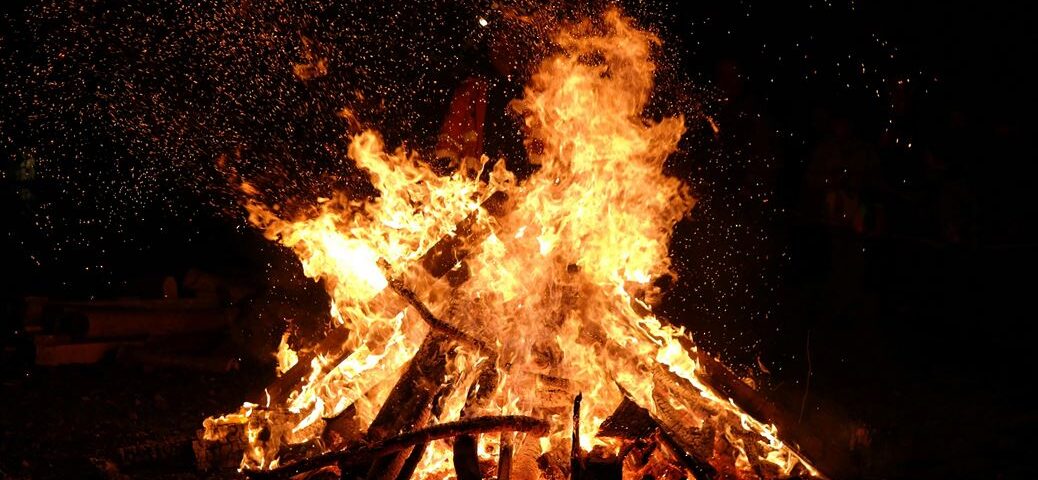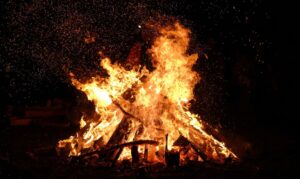TRADITION Questions: Banning Ritualized Fire

 Click here to read about this series.
Click here to read about this series.
What is it?
Last week, Israeli officials announced a complete ban on lighting fires in forests, camping grounds, and open areas across the country, allowing bonfires and outdoor open grilling only in designated areas. In anticipation of tonight’s celebration of Lag B’Omer and expected extreme weather, the ban will be in effect from May 9 through 18. Recent devastating fires in the Jerusalem hills fanned by strong winds and dry weather burnt 20,000 dunams (20 square km.) of forests and forced Israel to evacuate several communities.
Bonfires are the primary custom associated with Lag B’Omer. This custom is not recorded in the Talmud or Rishonim. While noting the permissibility of haircuts on Lag B’Omer, R. Moshe Isserles (1530-1572) describes miktzat simcha—minor rejoicing—on this day, without further explanation or, for that matter, any mention of fire. While the lighting of candles upon the grave of R. Shimon Bar Yohai was first recorded in a letter from 1742 describing R. Hayyim Ibn Atar’s visit to Meron, later travelers describe the extensive fire ceremony on Lag B’Omer (e.g., the travel journal Sefer Ahavat Zion from 1764).
Bonfires are not a typical form of Jewish religious practice. While candles play an essential role on Shabbat and Hannukka, large fires carry associations with the Temple’s destruction and the worship of Molekh. From where did this Lag B’Omer tradition emerge?
Why does it matter?
R. Moshe Sofer (1762-1839) criticizes the initiation of a “new” holiday that neither appears in the Talmud nor results from a modern deliverance from danger (Hatam Sofer, Y.D. 2:233). Likewise, R. Yosef Shaul Nathanson (1808–1875), in a responsa concerning events that took place in 1842, expresses frustration with Lag B’Omer fires. He specifically focuses on the custom of burning clothing on Lag B’Omer, a practice that also gains prominent mention in travel journals (although largely unfamiliar today). R. Nathanson maintains that “they are transgressing the prohibition against wasting and are engaging in superstitious practices which are forbidden” (Shoel u-Meshiv 5:39). In a polemical tone, he adds that this custom was obviously not practiced in the days of the Arizal, and he is certain that R. Yosef Karo would not have allowed it.
The centrality of clothing in these early ceremonies, when contrasted with modern Lag B’Omer practices, may reflect more than the relative prevalence of flammable materials. The great cost of textiles at the time and the extravagant descriptions of some of the garments used in the Meron ceremony suggest an anti-materialist asceticism tied to these ceremonies. They weren’t simply creating fire; they were destroying sartorial ostentatiousness. What would it mean to recapture this anti-materialist culture within our Lag B’Omer celebrations?
What questions remain?
Despite the protests of prominent rabbinic leaders in the 19th century, the bonfires continued. Will real concern for safety (for the environment as well as human life) extinguish the religious fervor around these conflagrations? Does the 2021 Meron disaster suggest that careless disregard for physical danger has become a component of Lag B’Omer culture and that adherence to these new regulations will be limited? Does the government’s failures as indicated in the March 2024 Meron Disaster Commission report show that indifference to safety (not to mention lawfulness) extends far beyond Lag B’Omer?
Today, forest fires are described as part of nature. While we find fire used by the prophets as metaphor (e.g., Zecharia 11:1-3; Jeremiah 21:14; Psalms 83:15), we do not find any historical descriptions of forest fires in Tanakh (as we find in the case of sieges, plagues, earthquakes, and famines). Why is that?
In 19th century Irish and Scottish ceremonies called Beltane, cattle were driven over flames or between two fires—as described in Sanas Cormaic almost 1000 years before. Sometimes the cattle would be driven around a bonfire or be made to leap over flames or embers (amazingly parallel to the dispute between Abaye and Rava in Sanhedrin 64b). The people themselves did likewise for good luck and protection. When the bonfire died down, people would daub themselves with its ashes and sprinkle it over their crops and livestock. From these rituals, it is clear that the fire was seen as having protective powers. Why does fire retain its ritual power even into modern times? How is it both a symbol for destruction and protection? How will its so-recently-felt destructive power affect Lag B’Omer this year?
In explaining the prohibition of Molekh, Maimonides writes of fire worshipers who would tell parents that passing their children through a fire initiation ceremony would protect them from death (Guide III:39). He describes how both the parents’ susceptibility to fears surrounding their children’s well-being and the relative simplicity of this ritual made them easy prey to devious priests. He thereby explains the Torah’s intense opposition to this ritual. How significant are the parallels between Maimonides’ words and fire ceremonies for ritual protection (both ancient and modern)?
Chaim Strauchler, rabbi of Rinat Yisrael in Teaneck, is an Associate Editor of TRADITION.

2 Comments
You are on firmer ground when critiquing these bonfires for safety reasons. However, once you start “deconstructing” it on theological and spiritual grounds, you are on much shakier territory. One can apply your methodology to so many other things Jews do, and before you realize it 20 to 40 percent of our practices will be gone. כלך לך אצל …
Thank you for this comment, Rabbi Katz.
There’s physical safety and there’s also theological and spiritual safety. We should examine the sources for our religious practices and understand the risks and opportunities involved in innovations – even those of past centuries. Our mesora is layered. Not everything was given at Sinai. We will live halakha more deeply and with more love the more that we understand its beautiful complexity.